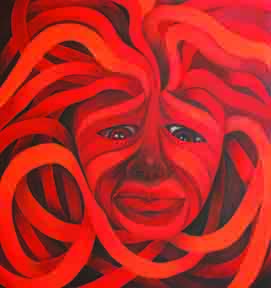Last month, The Scream – Norwegian artist Edvard Munch’s seminal expressionist work depicting existential angst – was brought to London. England was instantly aflush with the immense influence of this painting, considered by many as a portrayal of the fearful condition of modern man.
Now, here in Cambodia, another artist has taken human expression as a focus of his study on contemporary mankind. Long Kusal, the next artist to be celebrated in a solo exhibition at Romeet Gallery, is a philosopher as well as a painter. First and foremost, his paintings are about truth and the human condition and “portray problems towards the solutions”, Kusal says. His work is an experiment in destabilising overbearing truths or common perceptions.
Anarchy goes hand in hand with discontent and anger. Each of the 15 paintings in this show is painted in red, the colour of rage. Although some of the faces are smiling, Kusal insists that his expressions emerge from the same anger. “Even your smile is angry,” he says.
But the colour also has its connections with Buddhism, the methods of which Kusal relies upon for inspiration. In a state of meditation, Kusal once contemplated the thread which adorns the wrist of blessed Buddhists (also, their motorbikes and car wing-mirrors) – the first medium he worked in. Although he has since abandoned the thread itself, you can still see its influence in his paintings. The twisted lines which entangle his figures and emerge from their expressions are those same red threads, but in two-dimensional form.
These paintings contribute to a portrayal of the eternal human psychology. These are pure egos, illustrations of the “fear, shock, stress and sadness” which have driven mankind forever. “There are no positive ideas in my work, only conflict.”
Although the artist denies any positivity, a light emerges from this tyrannical will to see in concrete form the absence of hope. This hope can only emerge in the process of spectatorship. When people engage with Kusal’s work, they are faced with an unbearable image of humanity. Once engaged, they have the opportunity to contemplate the issue.
He doesn’t necessarily mean for his audience to leave depressed. “Once I have made the work, it is up to people what they make of it.” The creative process doesn’t end with Kusal. In fact, it has hardly begun. Art has the capacity to mean anything, he insists. “It can be funny, angry, positive and negative”. Art is pure potential; the ultimate power, then, rests with the audience.
WHO: Long Kusal
WHAT: Solo exhibition
WHERE: Romeet Gallery, #34E St. 178
WHEN: May 3
WHY: Rage on canvas
